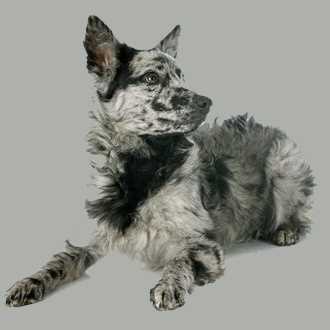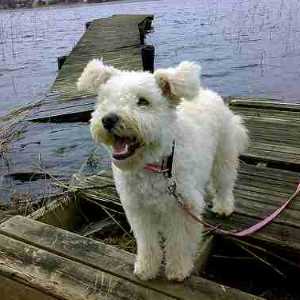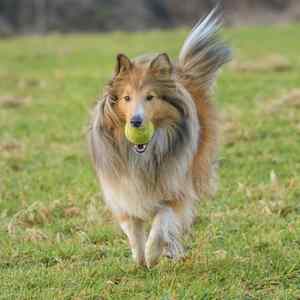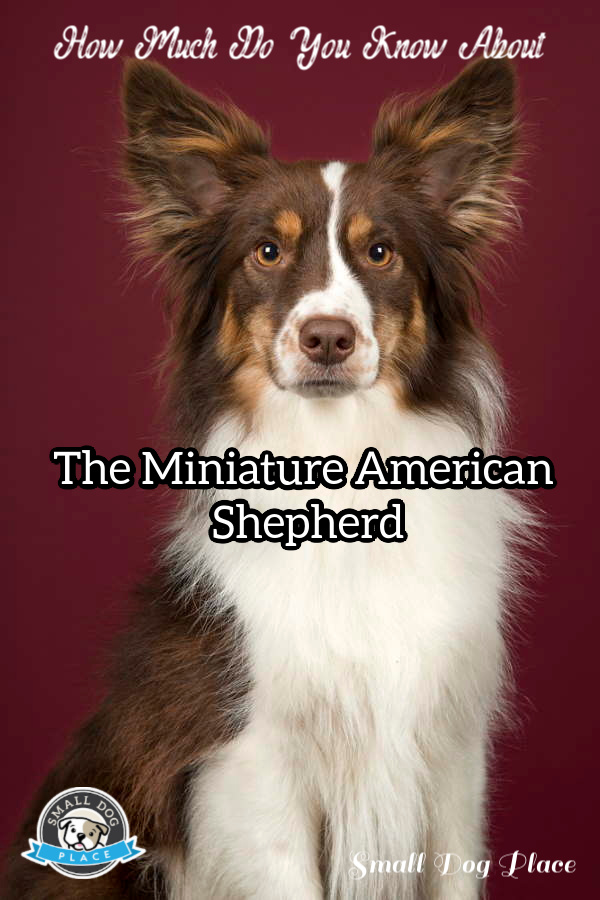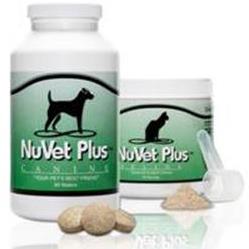- Small Dog Place Home
- A-Z Breeds A to M
- Miniature American Shepherd
Miniature American Shepherd
Miniature American Shepherd by Janice Jones |Last Updated 04-28-2024
Energetic, versatile, and bright are just a few ways to describe these little herding dogs that resemble their larger cousins, the Australian Shepard.
Here is a dog that has a natural or docked bobtail with often odd eye presentation.
One or both eyes may be brown, blue, hazel, amber or any combination of those colors, including flecks and marbling.
Those that own a Miniature American Shepherd think of them as a great family dog, gentle with children, tolerant of other dogs and household pets, and a joy to be around.
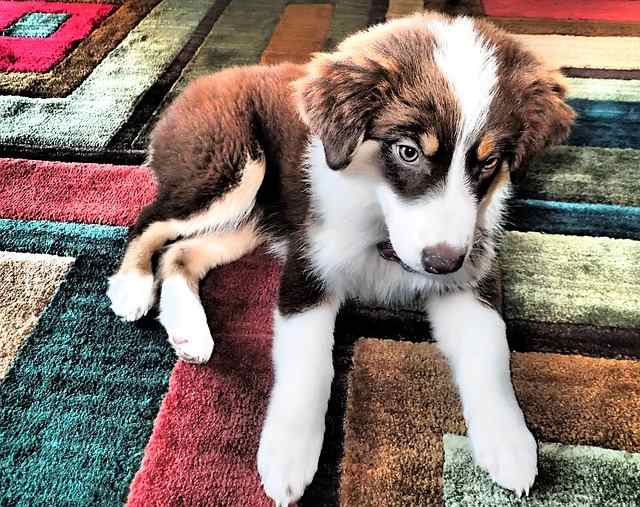 Miniature American Shepherd Puppy
Miniature American Shepherd PuppyJust like other herding breeds such as the Shetland Sheepdog, Pumi, and Puli, the Miniature American Shepherd is energetic and hard-working. His life style revolves around a job and he is devoted to doing a good job.
He loves to problem solve and enjoys a challenge so these dogs thrive in an environment with plenty of stimulation, learning games and tricks to learn.
Some owners go so far to suggest that you should be prepared to start spelling words in his presence because an Miniature American Shepherd can have an immense vocabulary.
Quick Facts
Other Names Used: Miniature Australian Shepherd, Berger Miniature Américain, Miniatur Amerikanischer Schäferhund, Pastor Miniatura Americano
Affiliation: AKC: Herding Group, FCI: Group 1, UKC: Herding
Size
Height: 14-18 inches (male), 13-17 inches (female)
Weight 20-40 pounds
Coat Type: Double coat, with a longer outer coat and a wooly undercoat.
Colors: Black, blue merle, red, and red merle with markings that include tan points, white markings, and white markings with tan points.
Country of Origin: United States
Activity Level: Activity
Life Expectancy: 12-15 years
Good with Children: Yes
Good with other pets: Yes
Cost: At least $1000 USD and up
Litter Size: 2 to 6 puppies
Personality/Temperament
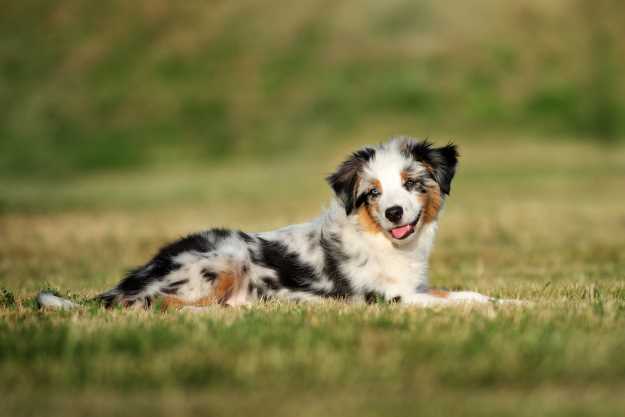
| Traits | Rating |
|---|---|
| Playfulness | |
| Affection Level | |
| Friendliness Towards Strangers | |
| Good with Children | |
| Good with Other Dogs | |
| Good for First Time Owners | |
| Exercise Needed | |
| Ease of Training | |
| Watch Dog Ability | |
| Grooming Requirements | |
| Shedding | |
| Cold Tolerant | |
| Heat Tolerant |
Explanations for At a Glance Ratings
- Playfulness: Most=5 Less=1
- Affection: Most=5 Least=1
- Friendliness Towards Strangers: Most=5 Least=1
- Good with Children: Good=5 Not Good=1
- Good with Other Dogs: Good=5 Not Good=1
- Good for First Time Owners: Good=5 Not Good=1
- Amount of Exercise Required: Much=5 Minimal=1
- Ease of Training: Easy=5 Difficult=1
- Watch Dog Ability: Excellent=5 Poor=1
- Grooming Needs: Extensive=5 Minimal=1
- Shedding: Heavy Shedding=5 Minimal Shedding=1
- Cold Tolerance: Cold Well Tolerated=5 Poorly Tolerated=1
- Heat Tolerance: Heat Well Tolerated=5 Poorly Tolerated=1
This is one small breed dog that is not only highly intelligent, with strong herding instincts and flock guardians, but also a breed that is easy to train, a hard worker, and a very devoted family member.
They need a job to do, so if you plan to have one as a pet, consider becoming involved in one of the many canine sports.
These dogs are considered to be neither shy or aggressive according to their breed standard.
They are affectionate and love their families, but would not be considered a cuddly lap dog. If that is what you are looking for, consider a different breed.
While many small dogs seem to bark for no apparent reason, the Miniature American Shepherd, may bark, they are not considered to be yappy, American Miniature Shepherds are guardians and will alert you if they think they are experiencing suspicious activity.
Beyond that, barking only occurs when dogs are not getting enough exercise and attention to avoid stressful behaviors.
Some Miniature American Shepherd dogs have been reported to be wary of strangers, but plenty of early socialization will help prevent this from becoming a problem.
History of the Miniature American Shepherd
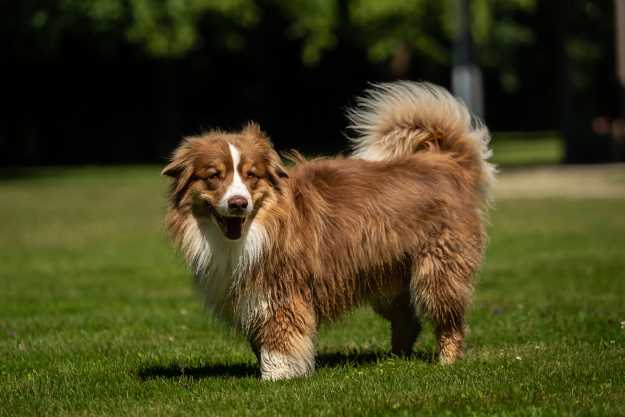
The Miniature American Shepherd have a short history that can be traced back to the 1960s. At the time, in California, USA, there was an attempt to breed these smaller versions of the Australian Shepherd that would maintain their active traits and intelligence.
They were particularly popular in the rodeo circuit and became very popular in all horse shows of the time.
Originally labeled, Miniature Australian Shepherds, they were gaining attention for their intelligence and loyalty not only with equestrians but with other spectators that followed rodeo shows.
Since the breed's development, it has been used to heard sheep and goats. Not only were they great with smaller livestock, they became very popular as household pets.
The Miniature American Shepherd soon became popular throughout the U.S. with a reputation as being a versatile herding dog and a family pet, both at ease on the ranch or farm or in the city.
In 2011, they were accepted into the Foundation Stock of the American Kennel Club and then assigned to be eligible to compete in the Herding Group in 2015.
Coat & Grooming
Most Miniature American Shepherds are much more interested in playing with their owners or learning a new trick than sitting still for an extensive grooming session.
They have a long double coat that does mat if brushing is neglected so it is important to make time for brushing.
Weekly or daily brushing help remove dirt and debris while also removing loose dead hairs will help them looking their best. Often a quick brush through can replace a bath even in the dirtiest of dogs.
A bath will be needed if you are trying to remove odor especially in dogs that enjoy rolling in stuff they probably should not be in. A mild shampoo along with a cream rinse will make the coat smell fresh and leave it feeling great. Otherwise a bath about every 4 to 6 weeks is usually sufficient.
Some mats or tangles can form if brushing is not sufficient and they can be removed with a slicker brush or metal comb along with a spritz of conditioning spray.
Shaving the coat is not recommended unless the mats can not be removed any other way. Most grooming tasks can be tackled at home, but you may prefer to have a professional groomer bathe, brush and trim legs, feet, ears and the stomach area.
Professional groomers can also use an undercoat rake that will remove much of the undercoat. In the summer months, this might be your best solution to help keep your dog cool.
Otherwise, their nails will need to be trimmed regular, ears checked and cleaned if needed, and teeth brushed. And, that's about all there is to it.
Health Concerns of the Miniature American Shepherd (formerly Mini Australian Shepherd)
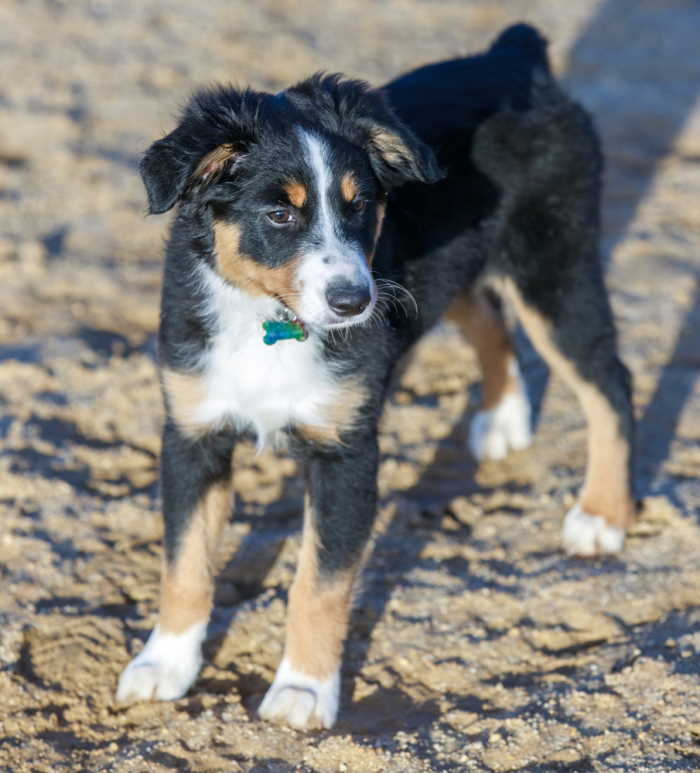
This is considered to be a healthy breed with a lifespan of between 12 and 15 years. There are some conditions, however, that have been identified in the breed.
Progressive retinal atrophy (PRA)
Micropthalmia, multi-drug resistance gene (MDR1)
It is important that you learn what your dog breeder is doing to improve the health of the breed. Ask to see the eye examination from a board-certified veterinary ophthalmologist from your puppies's parents for such tests as a progressive retinal atrophy (PRA) test.
An exam for hip dysplasia with results registered with OFA or CHIC or PennHIP or Federation Cynologique Internationale (FCI) hip dysplasia evaluation
Participation in OFA/CHIC DNA repository
The following exams are optional:
Collie eye anomaly (CEA) OptiGen test results registered with OFA
Best Suited for
This breed is suited for active singles, couples and families. They do best with families with older children living in the suburbs, rural or even cities.
- Active singles
- Outdoorsy types
- Families with older children
- City dwellers
Exercise and Activity Level
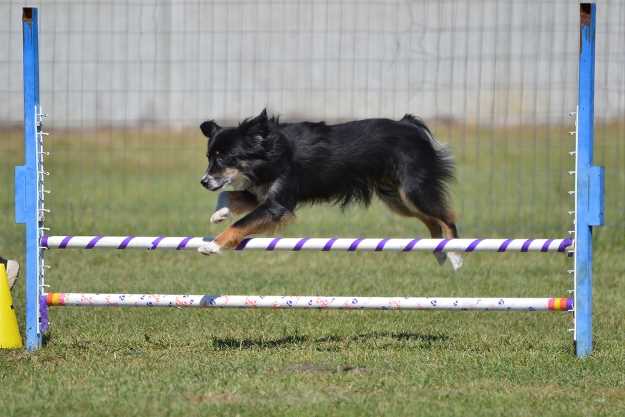
Miniature American Shepherds adapt readily to their environment and their family's lifestyle. They are active and can adapt to city, suburban, or rural life if given the amount of exercise and activity to keep them happy.
They are social creatures, like most dogs and will be quite happy accompanying their people on outings especially if they involve an activity that requires moderate activity.
For owners or families interested in canine sports such as obedience, agility or tracking, these dogs might be an ideal choice.
Training
As their cousins before them (Australian Shepherd) the Miniature American Shepherd is very smart and will respond well to training. But with that said, early socialization and puppy training is vital to help ensure that the puppy gets on the right tract to a lifetime as a well adjusted adult dog.
Miniature American Shepherds love to please and are easy to train so it is best to work with your puppy from an early age to teach basic skills, obedience and proper socialization.
Diet and Feeding
Depending on how active your Mini American Shepherd is you may want to consider a formula of dog food for active adults. Naturally you won't be feeding this formula until your puppy has reached adulthood.
Puppies have special requirements and should be kept on a puppy formula. As is the case with most small breed dogs, this breed matures at about 8 to 12 months of age and then can switch to an adult food. Puppies should be feed three times a day until they reach six months and then feed twice a day for the rest of their life.
Your best bet for feeding your dog is to choose the highest quality food that you can afford. This means finding a food that has a named meat or fish protein as the first and second ingredient, staying away from foods that contain corn or wheat in their top five ingredients list and including high-quality fiber and probiotics.
If you find your dog has developed a food allergy, check with your vet as you may need to change the formula. Often proteins are culprits and switching to a food with a novel protein source may alleviate the symptoms.
Pros of Living with A Miniature Australian Shepherd
- Smart and easy to train
- May take to potty training faster than other small breeds
- May be wary of strangers, so socialization is important
- Doesn't require a great deal of grooming
- Relatively healthy breed with few health problems
- Versatile, farm dog or urban family pet
- Devoted family dog
Cons:
- Active dogs that need much daily exercise
- Possess a herding instinct meaning they may try to herd you or your children.
Similar Breeds
Reference and Future Reading
Miniature American Shepherd Club USA
Pin for Future Reference
Share Your Experience Living with a Miniature Australian Shepherd
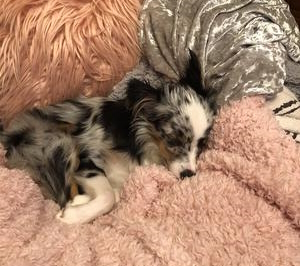
Janice, I love your page, it’s very informative!! We have a toy and she’s a sweet handful. She weighs about 12 lbs full grown at 9 months old.
She loves to play with her toys and be outside. She enjoys the cooler weather and does not really like the summer heat. My husband and I are followed everywhere and she has to be super close to both of us at night when we sleep.
She loves barking at birds, but stops when we tell her no barking. She loves people and other dogs, but gets OVER excited and we’re working on calming her down.
We’re still working on her coming to us off of the leash, she loves to run and run!! Once she’s tired, she eventually will let me catch her to go inside.
We live on a large family farm with lots of land to run, so it’s easier to get her adjusted to not being tied up all the time whenever she’s outside for fear of her running into the road.
My goal is to have her be able to roam around the farm with us and follow us right into the house when we’re done.
Right now her game she loves to play is “you can’t catch me, I’m too fast!!” My last final thought on this breed is she’s always happy!!
Next Steps
Are you currently sharing your home with a Miniature American Shepherd? I'd love to hear from you and share your dog with the readers of this site.
Please contact me to let me know that you own one of these amazing dogs. Let me know where you are located, what your dog's name is, and a paragraph or two about the personality of your dog. Your dog will be a celebrity. Contact Janice.
About Janice (author and voice behind this site)
Janice Jones has lived with dogs and cats for most of her life and worked as a veterinary technician for over a decade. She has also been a small-breed dog breeder and rescue advocate and holds academic training in psychology, biology, nursing, and mental health counseling. Her work focuses on helping dog owners make informed, responsible decisions rooted in experience, education, and compassion.
When not writing, reading, or researching dog-related topics, she likes to spend time with her six Shih Tzu dogs, her husband, and her family, as well as knitting and crocheting. She is also the voice behind Miracle Shih Tzu and Smart-Knit-Crocheting
Does This Article Deserve Your Thumbs Up?
We always appreciate your support and encouragement. Your thumbs up means so much to us. Please like this article.
If you find this page or any page on Small Dog Place Helpful, or useful in anyway, I'd love it if you would click the small heart found on the bottom right of each page.
You can also share or bookmark this page -- just click on the:
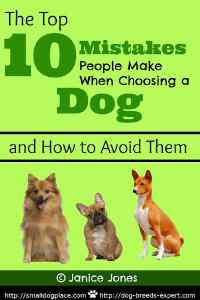
Free Monthly Newsletter
Sign Up for Our Free Newsletter and get our Free Gift to You.
my E-book, The Top 10 Mistakes People Make When Choosing a Dog (and how to avoid them)
